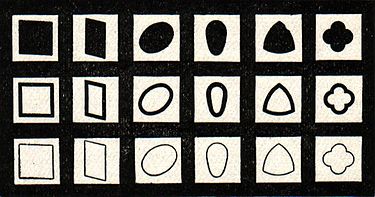The New Student's Reference Work/Montessori System
Montessori System. A system of education originated by Dr. Maria Montessori, of Rome; “the only example,” says Professor Holmes, of Harvard, “of an educational system worked out and inaugurated by the feminine mind.”
Within five years after a few Montessori schools were established in Rome—under quite unfavorable conditions—they were being talked about in every school system on the globe, and Dr. Montessori took rank with Froebel as the author of a profound and practical contribution to the greatest of the sciences.
By use of this system feeble minded children passed the public school examinations in Rome with higher credits than normal children outside the Montessori schools. Under the Montessori system normal children learn to read and write—for example—in six weeks, and—a matter of far wider importance—this progress is accompanied by the rapid yet wholesome development of the faculties and of the powers of resource, initiative, self control and concentration.
Who is Dr. Montessori? To what extent is her system adapted or adaptable to the needs and conditions of English speaking countries?
This article is intended to answer these questions, and to give details with regard to the Montessori apparatus that will enable mothers and teachers to employ the system to the best advantage.
WHAT EDUCATORS SAY ABOUT THE METHOD
In an extremely valuable analysis of the Montessori method, in his introduction to Dr. Montessori's work “The Montessori Method” (listed below in the bibliography of the subject), Professor Henry W. Holmes of Harvard says of the method, that “it leads to rapid, easy and substantial mastery of the elements of reading, writing and arithmetic.” He thinks it highly probable, however, that the system ultimately adopted in the American schools will combine elements of the Montessori and Kindergarten methods, and advises that several combinations be tried out. He points out that while the Kindergarten does not teach children to read and write, it does teach them to deal with number, and thinks it may be fairly questioned whether it does not do more fundamental work in this field than the Montessori system.
On the subject of teaching writing he says:
“There has been a fairly general conviction that writing is not especially important before the age of 8 or 9. In view of Dr. Montessori's teaching children of 4 or 5 to write with ease and skill, must we not revise our estimate of the value of writing and our procedure in teaching it?”
But, in his opinion, writing and reading for young children should not be unduly emphasized. He says:
“Let us remember, as Dr. Montessori does, that reading and writing should form but a subordinate part of the experience of the child, and should minister in general to his other needs. With the best of methods, the value of reading and writing before six, is questionable.”
“Of the technical advantages of the Montessori scheme for writing, there can be little doubt. . . . . The exercises have the very important characteristic of involving a thorough sensory analysis of the material to be mastered. Mauman has taught us the great value in all memory work, of complete impression through prolonged and intensive analytical study.”
But we must not expect as rapid advancement in writing and reading English as Dr. Montessori has achieved in teaching Italian:
“In Italian, the letters once learned, it is a simple matter to combine them into words, Italian spelling is so phonetic, but it is the unphonetic character of English spelling which has largely influenced us to give up the alphabet method of teaching children to read. We have found it more effective to teach whole sentences or rhymes by sight and then analyze the words thus acquired into their phonetic elements. The mastery of the alphabet by the Montessori Method will be of great assistance in teaching children to write, but of only incidental assistance in teaching them to read and spell.”
“The child passes step by step from solid objects to a mere drawing representing the figure.”
BOOKS ON MONTESSORI WORK
The Montessori Method, by Dr. Maria Montessori, is a valuable text for constant study. Pedagogical Anthropology, by Dr. Montessori, is highly technical and is for educators, teachers and other students of education. The Montessori Mother, by Dorothy Canfield Fisher, is a popular exposition of the method with good description of a Children's House in Rome. The Montessori Manual, by the same author, is a book written to help mothers to use the Montessori apparatus in their own homes. One of the ablest, most practical and most readable books, both for mothers and teachers is The Montessori Principles and Practice by E. P. Culverwell, Dublin Professor of Education, University of Dublin. See also McClure's Magazine, May, 1911; Dec., 1911; Jan., 1912; June, 1912. South Dakota Educator, April, 1912; Kindergarten Primary Magazine, June, 1912; American Primary Teacher, April and June, 1912; Northwest Journal of Education, April, 1912; Elementary School Teacher, Feb., 1912; Primary Education, June, 1912; Journal of Education, April 11, and July 4, 1912.
